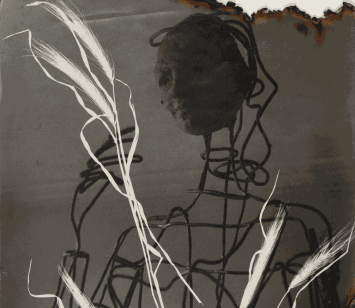"Surrealism... takes great advantage of equivocation and lends itself to a number of transpositions’, said André Breton. I think that the photographer who so much suggests, describes or finds (if he has the duty never to falsify) also has the right to use his shots as material likely to generate the Dream. Surrealism is often derisory or cruel, so why shouldn't it be kind and poetic?" - Pierre Jahan, Objectif.
Born in 1909, Pierre Jahan was part of a generation of pioneers who saw photography not as a scientific or technical practice, but as an art of pleasure and freedom. He joined Henri-Cartier Bresson, Man Ray, Lee Miller, Laszlo Moholy-Nagy, Dora Maar and their colleagues on the other side of the Atlantic, such as Alfred Stieglitz, in the quest for recognition of photography as an art form in its own right, with its own visual and expressive possibilities. A versatile and unclassifiable figure in the avant-garde, Pierre Jahan sees photography as an exercise ground, the only law being the pleasure of the eye and the hand.
Pierre Jahan's work, which was particularly diverse, contributed to the surrealist movement. In 1938, the photographer attended - and immortalised - the International Surrealist Exhibition organised by André Breton and Paul Eluard at the Georges Wildenstein gallery in the Faubourg Saint-Honoré. The unusual and random combinations of objects must have left a lasting impression on the young Jahan. Pierre Jahan is one of the artists who experimented with photography without a camera, along with Moholy-Nagy, Man Ray and Christian Schad. The photogram - or rayogram in Man Ray's term - consists of superimposing an object between photosensitive paper and a light source, in order to fix the image afterwards.
Perhaps Jahan's most surprising series in this technique is the "Herbier surréaliste" of 1945. Unlike Man Ray, Jahan returned to the scientific origins of the photogram: specimens of grasses and other plants superimposed on photographs. Unexpectedly, the fire in his flat - and studio - in 1947 completed the works. The photographs in the Herbarium were partially burnt, creating a new plastic dimension to the image. Although the fire was an accident, it does not deny its contribution to Jahan's work - chance always plays a fundamental role in Surrealism, after all. It is one of its fundamental elements. The fire makes "L'Herbier" even more surreal.
-
 Pierre JahanL'Herbier surréaliste (Hordeum Murinum), 1945-1948Gelatin silver print, photogram, burnt edges40 × 31 cm
Pierre JahanL'Herbier surréaliste (Hordeum Murinum), 1945-1948Gelatin silver print, photogram, burnt edges40 × 31 cm -
 Pierre JahanL'Herbier surréaliste (Arrehenathrum Elatius), 1945-1948Gelatin-silver print, photogram and burnt edges40 × 31 cm
Pierre JahanL'Herbier surréaliste (Arrehenathrum Elatius), 1945-1948Gelatin-silver print, photogram and burnt edges40 × 31 cm -
 Pierre JahanL'Herbier surréaliste (Artemisia Estracunculus), 1945-1948Gelatin silver print, photogram, burnt edges40 × 31 cm
Pierre JahanL'Herbier surréaliste (Artemisia Estracunculus), 1945-1948Gelatin silver print, photogram, burnt edges40 × 31 cm -
 Pierre JahanL'Herbier surréaliste (Carduus Nutans), 1945-1948Gelatin silver print, photogram, burnt edges40 × 31 cm
Pierre JahanL'Herbier surréaliste (Carduus Nutans), 1945-1948Gelatin silver print, photogram, burnt edges40 × 31 cm -
 Pierre JahanL'Herbier surréaliste (Cirsium Palustre), 1945-1948Gelatin silver print, photogram and burnt edges40 × 31 cm
Pierre JahanL'Herbier surréaliste (Cirsium Palustre), 1945-1948Gelatin silver print, photogram and burnt edges40 × 31 cm -
 Pierre JahanL'Herbier surréaliste (Lotus Corniculatus), 1945-1948Gelatin silver print, photogram, burnt edges40 × 31 cm
Pierre JahanL'Herbier surréaliste (Lotus Corniculatus), 1945-1948Gelatin silver print, photogram, burnt edges40 × 31 cm -
 Pierre JahanL'Herbier surréaliste (Urtica Dioïca), 1945-1948Gelatin silver print, photogram, burnt edges40 × 31 cm
Pierre JahanL'Herbier surréaliste (Urtica Dioïca), 1945-1948Gelatin silver print, photogram, burnt edges40 × 31 cm -
 Pierre JahanSans titre (Herbier), 1945-1948Gelatin silver print, photogram, burnt edges40 × 31 cm
Pierre JahanSans titre (Herbier), 1945-1948Gelatin silver print, photogram, burnt edges40 × 31 cm -
 Pierre JahanL'Herbier surréaliste. Photogramme autour du graminée, 1945/48Photogramme40 x 31 cmUnique
Pierre JahanL'Herbier surréaliste. Photogramme autour du graminée, 1945/48Photogramme40 x 31 cmUnique









